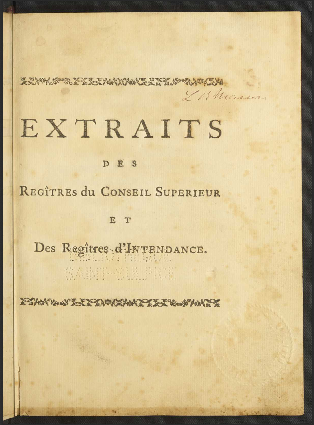bloc_article_content
Governors and Intendants in New France
In New France, the colonial administration was embodied by two main figures: the governor and the intendant.
The governor as master of the country
In the early 17th century, the King did not govern his colonies directly. They were administered by companies who obtained a trade monopoly in the territory in exchange for an annuity and obligations for settlement.
The first governor, Charles Huault de Montmagny, arrived in 1636, at the time of the Company of One Hundred Associates. The administration was rudimentary at the time and the governor combined the roles of military leader, legislator, judge and administrator. He could pronounce ordinances and judge offenders himself. Responsible for the defence of the colony, diplomatic relations with the Amerindians and the concession of seigneuries, his main charge was to preserve order, while protecting the inhabitants and the territory.
1663: a decisive year
In 1663, the young King Louis XIV ordered the dissolution of the Company of One Hundred Associates and brought New France back into the territories of the King. The colony then acquired institutions allowing for the direct control of the monarchy. Until the end of the French regime, two figures lay at the heart of the colonial administration: the governor and the intendant.
1663 was also marked by the setting-up of an appellate court for civil and criminal cases, the Sovereign Council, and the appointment of an intendant, Louis Robert de Fortel. However, he never set foot in the colony, which might explain why 1665 is recalled as the initiation of colonial intendants, with the arrival of Jean Talon.
The setting-up of the Sovereign Council and the arrival of an intendant for justice, the police and finances had an important impact on the function of the governor, who lost his prerogatives in these fields. So, his power became concentrated in the military and diplomatic domains, in particulier the command of troops and militia, as well as diplomacy with the native peoples. But the governor still remained the King’s personal representative and, in this respect, retained the highest rank in the colonial territory.
New France was divided into governments, each directed by its own governor who reported to the Governor General who was based in Quebec. The various governors were officers in charge of a “place of war”, in other words, a fortified town with a garrison. The “places of war” in New France were Quebec, Trois-Rivières, Montreal, Louisburg and New-Orleans. Each governor had to watch over the security of his town, including the upkeep of its fortifications, as well as the accommodation and feeding of the troops. He was seconded by a staff made up of a king’s lieutenant, a major and an assistant-major.
Responsibilities and collaborations
Although conflicts between governors and intendants were much talked of, and the porous border between some of their responsibilities was a source of frictions, they generally collaborated in the carrying-out their functions. Together, they drafted an annual report for the King about the state of the colony and acted jointly in several fields, including the concession of seigneuries. In emergencies, they could not always wait for directives from Versailles and had to make shared decisions for the good of the colony.
While the Governor General was the King’s personal representative, the intendant was his delegate, responsible for executing his policies and guaranteeing the application of his laws. The intendant of justice, the police and finances saw to it that justice was done by watching over the ordinary tribunals and judging certain cases himself as a last resort. As of 1680, he officially took on the presidency of the Sovereign Council, which meant listening to the recommendations of counsellors, counting votes and pronouncing decrees.
The intendant was also responsible for the police, a vast field which among other things included public security, highways and fire prevention. Finally, he had important financial responsibilities, including managing the budget and the control of expenditure (including the army), as well as supplying the King’s stores. More generally, the intendant had to adopt measures to favour settlements, agriculture, trade, fishing and industries. Based in Quebec, he could count on a network of sub-delegates to represent him, serve him and relay his authority.
The intendant’s authority lay above all in his capacity to judge, as the monarch’s delegate, so as to execute his wishes. Whether responding to requests from Versailles, dealing with applications from litigants or acting on his own initiative, the intendant dealt with the business brought to his attention case by case, either by gathering information or by advising his superior through recommendations and memoranda, or else by governing himself by using ordinances or requesting the King’s intervention through an edict, decree or royal command. Still a work-in-progress in the 17th century, this intermediate position between the centre and the periphery became consolidated over the decades, until the intendant became “the King’s eye and hand” and the local embodiment of the monarch’s paternal protection of his subjects across the Atlantic.
Published in september 2020
Picture caption : Édits, ordonnances royaux, déclarations et arrêts du Conseil d'État du Roi concernant le Canada. 1803-1806









